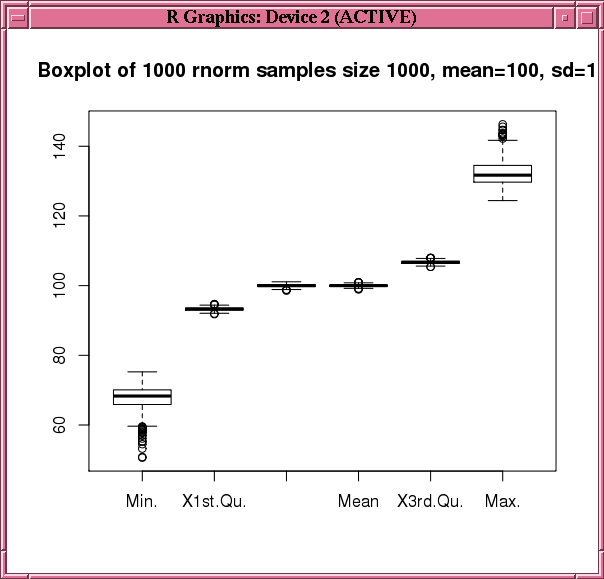6.2.7.3 Simulations Use Case
You can use the ore.indexApply function in simulations, which can take advantage of high-performance computing hardware like an Oracle Exadata Database Machine. Example 6-19 takes multiple samples from a random normal distribution to compare the distribution of the summary statistics. Each simulation occurs in a separate R engine in the database, in parallel, up to the degree of parallelism allowed by the database.
Example 6-19 defines variables for the sample size, the mean and standard deviations of the random numbers, and the number of simulations to perform. The example specifies num.simulations as the first argument to the ore.indexApply function. The ore.indexApply function passes num.simulations to the user-defined function as the index argument. This input function then sets the random seed based on the index so that each invocation of the input function generates a different set of random numbers.
The input function next uses the rnorm function to produce sample.size random normal values. It invokes the summary function on the vector of random numbers, and then prepares a data.frame as the result it returns. The ore.indexApply function specifies the FUN.VALUE argument so that it returns an ore.frame that structures the combined results of the simulations. The res variable gets the ore.frame returned by the ore.indexApply function.
To get the distribution of samples, the example invokes the boxplot function on the data.frame that is the result of using the ore.pull function to bring selected columns from res to the client.
Example 6-19 Using the ore.indexApply Function in a Simulation
res <- NULL
sample.size = 1000
mean.val = 100
std.dev.val = 10
num.simulations = 1000
res <- ore.indexApply(num.simulations,
function(index, sample.size = 1000, mean = 0, std.dev = 1) {
set.seed(index)
x <- rnorm(sample.size, mean, std.dev)
ss <- summary(x)
attr.names <- attr(ss, "names")
stats <- data.frame(matrix(ss, 1, length(ss)))
names(stats) <- attr.names
stats$index <- index
stats
},
FUN.VALUE=data.frame(Min. = numeric(0),
"1st Qu." = numeric(0),
Median = numeric(0),
Mean = numeric(0),
"3rd Qu." = numeric(0),
Max. = numeric(0),
Index = numeric(0)),
parallel = TRUE,
sample.size = sample.size,
mean = mean.val, std.dev = std.dev.val)
options("ore.warn.order" = FALSE)
head(res, 3)
tail(res, 3)
boxplot(ore.pull(res[, 1:6]),
main=sprintf("Boxplot of %d rnorm samples size %d, mean=%d, sd=%d",
num.simulations, sample.size, mean.val, std.dev.val))
Listing for Example 6-19
R> res <- ore.indexApply(num.simulations,
+ function(index, sample.size = 1000, mean = 0, std.dev = 1) {
+ set.seed(index)
+ x <- rnorm(sample.size, mean, std.dev)
+ ss <- summary(x)
+ attr.names <- attr(ss, "names")
+ stats <- data.frame(matrix(ss, 1, length(ss)))
+ names(stats) <- attr.names
+ stats$index <- index
+ stats
+ },
+ FUN.VALUE=data.frame(Min. = numeric(0),
+ "1st Qu." = numeric(0),
+ Median = numeric(0),
+ Mean = numeric(0),
+ "3rd Qu." = numeric(0),
+ Max. = numeric(0),
+ Index = numeric(0)),
+ parallel = TRUE,
+ sample.size = sample.size,
+ mean = mean.val, std.dev = std.dev.val)
R> options("ore.warn.order" = FALSE)
R> head(res, 3)
Min. X1st.Qu. Median Mean X3rd.Qu. Max. Index
1 67.56 93.11 99.42 99.30 105.8 128.0 847
2 67.73 94.19 99.86 100.10 106.3 130.7 258
3 65.58 93.15 99.78 99.82 106.2 134.3 264
R> tail(res, 3)
Min. X1st.Qu. Median Mean X3rd.Qu. Max. Index
1 65.02 93.44 100.2 100.20 106.9 134.0 5
2 71.60 93.34 99.6 99.66 106.4 131.7 4
3 69.44 93.15 100.3 100.10 106.8 135.2 3
R> boxplot(ore.pull(res[, 1:6]),
+ main=sprintf("Boxplot of %d rnorm samples size %d, mean=%d, sd=%d",
+ num.simulations, sample.size, mean.val, std.dev.val))
Figure 6-2 Display of the boxplot Function in Example 6-19

Description of "Figure 6-2 Display of the boxplot Function in Example 6-19"